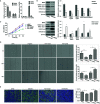Overexpression of EZH2/NSD2 Histone Methyltransferase Axis Predicts Poor Prognosis and Accelerates Tumor Progression in Triple-Negative Breast Cancer
- PMID: 33665162
- PMCID: PMC7921704
- DOI: 10.3389/fonc.2020.600514
Overexpression of EZH2/NSD2 Histone Methyltransferase Axis Predicts Poor Prognosis and Accelerates Tumor Progression in Triple-Negative Breast Cancer
Abstract
Two histone methyltransferases, enhancer of zeste homolog 2 (EZH2) and nuclear SET domain-containing 2 (NSD2), are aberrantly expressed in several types of human cancers. However, the regulatory relationship between EZH2 and NSD2 and their prognostic values in breast cancer (BC) have not been fully elucidated. In this study, we demonstrated that EZH2 and NSD2 were overexpressed in BC compared with benign lesions and normal tissues using tissue microarray, immunohistochemistry, and bioinformatic databases. Both EZH2 and NSD2 expression were associated with pathological grade of tumor and lymph node metastasis. A comprehensive survival analysis using Kaplan-Meier Plotter database indicated that EZH2 expression was negatively correlated with relapse-free survival (RFS), overall survival (OS), distant metastasis-free survival (DMFS), and postprogression survival (PPS) in 3951 BC patients, and NSD2 expression was negatively correlated with RFS and DMFS. Notably, EZH2 and NSD2 expression were coordinately higher in triple-negative breast cancer (TNBC) than that in other subtypes. Stable knockdown of EZH2 using lentiviral shRNA vector significantly reduced the proliferation, migration and invasion abilities of TNBC cell line MDA-MB-231 and MDA-MB-468, and downregulated NSD2 expression as well as the levels of H3K27me3 and H3K36me2, two histone methylation markers catalyzed by EZH2 and NSD2, respectively. By contrast, overexpression of EZH2 using adenovirus vector displayed an inverse phenotype. Furthermore, knockdown of NSD2 in EZH2-overexpressing cells could dramatically attenuate EZH2-mediated oncogenic effects. Bioinformatic analysis further revealed the function and pathway enrichments of co-expressed genes and interactive genes of EZH2/NSD2 axis, suggesting that EZH2/NSD2 axis was associated with cell division, mitotic nuclear division and transition of mitotic cell cycle in TNBC. Taken together, EZH2/NSD2 axis may act as a predictive marker for poor prognosis and accelerate the progression of TNBC.
Keywords: EZH2; NSD2; prognosis; progression; triple-negative breast cancer.
Copyright © 2021 Gao, Liu, Li, Zhao and Pan.
Conflict of interest statement
The authors declare that the research was conducted in the absence of any commercial or financial relationships that could be construed as a potential conflict of interest.
Figures










Similar articles
-
Tandem histone methyltransferase upregulation defines a unique aggressive prostate cancer phenotype.Br J Cancer. 2021 Jul;125(2):247-254. doi: 10.1038/s41416-021-01398-7. Epub 2021 May 11. Br J Cancer. 2021. PMID: 33976366 Free PMC article.
-
Overexpression of CDCA7 predicts poor prognosis and induces EZH2-mediated progression of triple-negative breast cancer.Int J Cancer. 2018 Nov 15;143(10):2602-2613. doi: 10.1002/ijc.31766. Epub 2018 Sep 19. Int J Cancer. 2018. PMID: 30151890
-
Histone methyltransferase NSD2 mediates the survival and invasion of triple-negative breast cancer cells via stimulating ADAM9-EGFR-AKT signaling.Acta Pharmacol Sin. 2019 Aug;40(8):1067-1075. doi: 10.1038/s41401-018-0199-z. Epub 2019 Jan 22. Acta Pharmacol Sin. 2019. PMID: 30670815 Free PMC article.
-
The Role of Methyltransferase NSD2 as a Potential Oncogene in Human Solid Tumors.Onco Targets Ther. 2020 Jul 13;13:6837-6846. doi: 10.2147/OTT.S259873. eCollection 2020. Onco Targets Ther. 2020. PMID: 32764971 Free PMC article. Review.
-
Clinical and prognostic relevance of EZH2 in breast cancer: A meta-analysis.Biomed Pharmacother. 2015 Oct;75:218-25. doi: 10.1016/j.biopha.2015.07.038. Epub 2015 Aug 10. Biomed Pharmacother. 2015. PMID: 26271144 Review.
Cited by
-
High EZH2 Protein Expression Is a Poor Prognostic Predictor in IDH1 R132H-Negative Gliomas.Diagnostics (Basel). 2022 Sep 30;12(10):2383. doi: 10.3390/diagnostics12102383. Diagnostics (Basel). 2022. PMID: 36292072 Free PMC article.
-
Structural and functional specificity of H3K36 methylation.Epigenetics Chromatin. 2022 May 18;15(1):17. doi: 10.1186/s13072-022-00446-7. Epigenetics Chromatin. 2022. PMID: 35581654 Free PMC article. Review.
-
Clinicopathological Analysis of Expression of Enhancer of Zeste Homologue 2 in Canine Mammary Carcinoma.J Vet Res. 2022 Jul 5;66(2):267-272. doi: 10.2478/jvetres-2022-0033. eCollection 2022 Jun. J Vet Res. 2022. PMID: 35892097 Free PMC article.
-
DNA Methylation-Based Diagnosis and Treatment of Breast Cancer.Curr Cancer Drug Targets. 2025;25(1):26-37. doi: 10.2174/0115680096278978240204162353. Curr Cancer Drug Targets. 2025. PMID: 38441008 Review.
-
Dual-target EZH2 inhibitor: latest advances in medicinal chemistry.Future Med Chem. 2024 Aug 2;16(15):1561-1582. doi: 10.1080/17568919.2024.2380243. Epub 2024 Jul 31. Future Med Chem. 2024. PMID: 39082677 Free PMC article. Review.
References
LinkOut - more resources
Full Text Sources
Other Literature Sources
Miscellaneous

